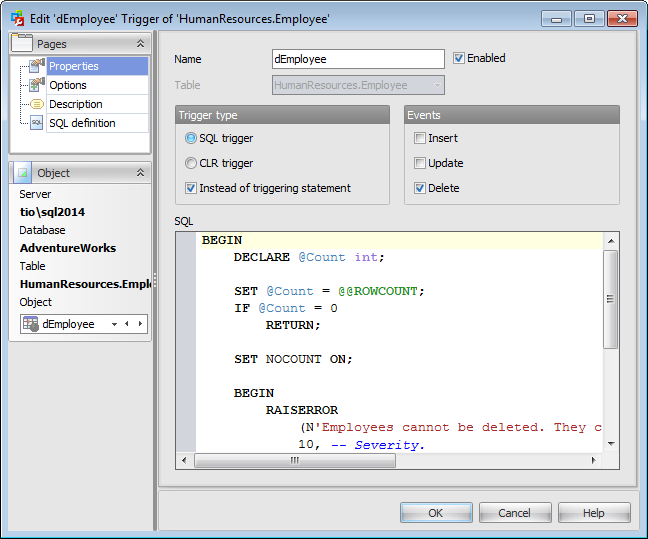Online Documentation for SQL Administrator for SQL Server
Properties
Use the Properties tab of the Trigger Editor to create/edit a DML trigger and specify its properties.
Name
Enter a name for the new trigger, or modify the name of the trigger being edited.

Table
In this field the Table name of the trigger being edited is displayed.
![]() Enabled
Enabled
Enables/disables the trigger immediately after it is created. Enabling a trigger causes it to fire when any Transact-SQL statements on which it was originally programmed are executed. A disabled trigger still exists as an object in the current database, but does not fire.
Trigger type
Select whether the trigger should be created directly from Transact-SQL statements (![]() SQL trigger) or from methods of assemblies that are created in the Microsoft .NET (
SQL trigger) or from methods of assemblies that are created in the Microsoft .NET (![]() CLR trigger).
CLR trigger).
![]() Instead of triggering statement
Instead of triggering statement
This selection specifies that the trigger is executed instead of the triggering SQL statement. Otherwise, it is fired only when all operations specified in the triggering SQL statement have executed successfully.
Events
Specify the data modification statements that activate the trigger when it is tried against this table or view: Insert, Update or Delete. At least one option must be specified.
For SQL trigger Specify the trigger conditions and actions. Trigger conditions specify additional criteria that determine whether the tried DML, DDL, or logon events cause the trigger actions to be performed.
For a CLR trigger, specify the Method of an Assembly to bind with the trigger. The method must take no arguments and return void. Class name must be a valid SQL Server identifier and must exist as a class in the assembly with assembly visibility. If the class has a namespace-qualified name that uses '.' to separate namespace parts, the class name must be delimited by using [ ] or " " delimiters. The class cannot be a nested class.



































































